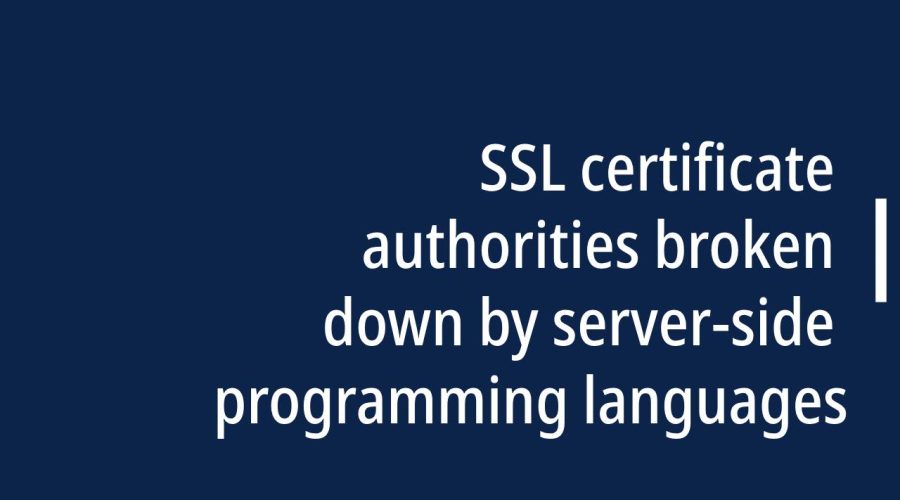- October 15, 2023
- Gloria Bradford
SSL certificates are issued by Certificate Authorities (CAs) and serve as a trust mechanism to establish secure connections between web servers and clients. The usage of SSL certificates varies across different server-side programming languages. In this blog, we’ll explore how SSL certificate authorities are utilized in various server-side programming languages, including Java, Python, Ruby, and Node.js.
Table of Contents
ToggleJava
Java is a popular server-side programming language used in building robust and secure web applications. In Java, the usage of SSL certificates and interaction with CAs is typically done through the Java KeyStore and TrustStore.
KeyStore: This is a file that contains private keys and certificates. In Java, you can use the KeyStore to manage your server’s SSL certificate.
TrustStore: This is a repository of certificates from trusted CAs. It is used to verify the authenticity of SSL certificates presented by clients during communication.
Java provides APIs like javax.net.ssl and libraries like Bouncy Castle to facilitate SSL certificate management. You can request SSL certificates from CA providers like DigiCert, Symantec, or Let’s Encrypt, and then install and configure them in your Java-based web server.
Python
Python is known for its simplicity and versatility. When it comes to SSL certificates and CAs, Python leverages the ssl module and external libraries like OpenSSL and cryptography.
With Python, you can perform tasks such as generating Certificate Signing Requests (CSRs), obtaining certificates, and setting up secure connections using the ssl module. Popular CA providers for Python applications include GlobalSign and Comodo.
Ruby
Ruby is a dynamic, object-oriented language commonly used for web development. In the Ruby world, the openssl library is instrumental in managing SSL certificates. Ruby on Rails, a popular web framework, makes it relatively easy to configure SSL certificates.
To obtain an SSL certificate, you can use the openssl command-line tool to generate a CSR, submit it to a CA, and receive the certificate. Then, you can configure your Ruby application to use the certificate for secure connections. Popular CA providers for Ruby applications include GeoTrust and RapidSSL.
Node.js
Node.js has gained immense popularity for building scalable and real-time web applications. When dealing with SSL certificates in Node.js, the crypto and https modules are key components.
To implement SSL in Node.js, you typically start by creating a private key and CSR. You can then submit the CSR to a CA like Sectigo or GoDaddy. Once you receive the certificate, you can use it with the https module to secure your Node.js application.
Common Best Practices for SSL Certificates
Regardless of the server-side programming language you choose, there are some universal best practices to follow when dealing with SSL certificates:
- Stay Updated: Keep your server-side language, libraries, and SSL certificates up to date to patch security vulnerabilities.
- Use a Reputable CA: Choose a trusted and established Certificate Authority to ensure the validity and security of your SSL certificates.
- Implement Strong Encryption: Configure your server to use strong encryption algorithms and protocols, such as TLS 1.2 or 1.3, to enhance security.
- Regularly Renew Certificates: SSL certificates have expiration dates. Make sure to renew them in a timely manner to avoid service disruptions.
Conclusion
SSL certificates are crucial for securing online communications and establishing trust between web servers and clients. The choice of server-side programming language doesn’t significantly impact the process of obtaining, configuring, and maintaining SSL certificates. Each language provides tools and libraries to facilitate these tasks. However, it’s essential to follow best practices and choose a reputable CA to ensure the security and authenticity of your SSL certificates, regardless of the language you use. As online security threats evolve, staying informed and proactive is key to maintaining a secure web application.

Gloria Bradford is a renowned expert in the field of encryption, widely recognized for her pioneering work in safeguarding digital information and communication. With a career spanning over two decades, she has played a pivotal role in shaping the landscape of cybersecurity and data protection.
Throughout her illustrious career, Gloria has occupied key roles in both private industry and government agencies. Her expertise has been instrumental in developing state-of-the-art encryption and code signing technologies that have fortified digital fortresses against the relentless tide of cyber threats.
